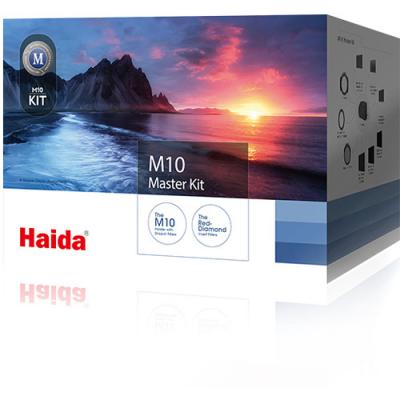Featuring a new quick release design, the new M10 filter holder allows for fast filter installation and ease of operation. First install the adapter ring, then the holder, then it's just an easy "drop-in" process to inserting filters. The included CPL will lock in to place with just a push and can be easily removed by pulling outward on the filter. Once the top gear is turned the CPL will rotate smoothly.
The M10 100mm filter holder is made from aviation grade aluminum and PC materials, resulting in a strong and durable filter holder that is also lightweight. The M10 holder is designed to allow for use of up to 2 filters (100x100mm or 100x150mm) as well as the round CPL on a full frame camera at a focal length of 16mm without vignetting. A full 360-degree light gasket is fitted to prevent light leakage on long exposures. Haida’s latest line, Red Diamond filters, promises all the advantages of the Nanopro filters and are engineered to be the toughest line of filters in Haida's current offerings.
The Red Diamond filters feature a shock-and-scratch-resistant design, making them ideally suited to the harsh challenges of outdoor landscape photography. Haida Red Diamond Filters feature an ultra-thin Nano Multicoating that retains superb image sharpness as well as delivering true color with zero color cast. The Red Diamond series is double the strength of a normal glass filter, which provides for a low risk of accidental breakage. An ND Filter provides a solid stop exposure, creating a darkening of the entire image and allowing you photograph with a wider aperture and slower shutter speed. By slowing your exposure time or increasing your aperture, you are able to control depth of field and convey movement more easily.
Medium Edge Graduated Neutral Density Filters start clear at the bottom of the filter before transitioning into the neutral density effect as it approaches the center and gradually becoming strongest at the top of the filter.
Hard Edge Graduated Neutral Density Filters start clear at the bottom of the filter, but feature a sharp transition in the neutral density portion of the filter, creating a flat transition line in the filter that can be lined up with flat horizon lines in your images. Hard grads are especially helpful when shooting the ocean, where the water meeting the land creates a flat horizon line.
Reverse Graduated Neutral Density Filters feature a sharp transition between the clear portion of the filter and the neutral density portion, but are strongest at the center of the filter before becoming lighter at the top of the filter. Reverse grads are especially helpful for shooting sunrises and sunsets.



